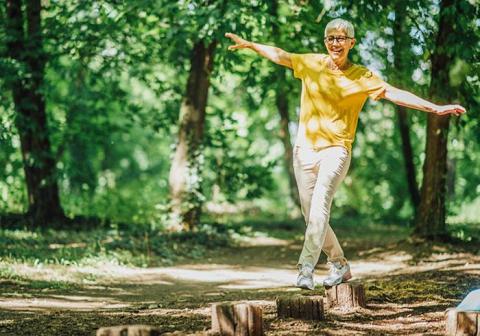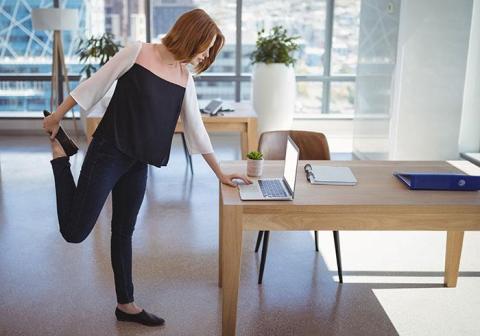Balance training is a critical aspect of fitness, especially for older adults. As we age, we typically lose muscle mass, and as a result, we lose strength. That's usually compounded by other factors, such as vision loss, mental decline and inner ear disorders. As early as our thirties, we start to lose the sense of where we are in space.
So what's the problem with a little wobbling? Well, the instability itself isn't really the issue. But being off balance can put you at risk for falling, and that's where the real harm is done. It can lead to broken bones, brain injury (if you hit your head) and even death.

Target: Core
Your core—that’s your torso, including your chest, abdomen, back and buttocks—gives your entire body stability. If you're weak in the core, you're going to have less ability to access strength in your extremities. Consider this scenario: You've strengthened your arms until your biceps bulge, but your core is weak. Your arms might be able to lift that heavy box, but you won't be able to carry it if you can't stabilize your spine.
To prevent this and improve your balance, it's important to do exercises that target your core. That doesn't mean you have to do 50 crunches a day. Simple balance exercises will work the core, provided you mind your posture.
Target: Legs
Strengthening your legs is a necessary element of balance training. People with muscle weakness, especially in the legs, are four times as likely to lose balance and fall as their stronger peers.
There are easy ways to build muscle in your lower body, including tai chi, yoga, indoor biking and water aerobics. Plenty of exercises can be done at home, too. Standing on one leg is one of the best beginner's exercises you can do, and it's easy to fit into your daily routine. Do it while you brush your teeth, placing a hand on a counter or wall as necessary for balance.
For strong calves, try doing calf raises when waiting at cash registers or elsewhere. Just rise to the balls of your feet and then lower yourself, repeating the process 10 times. You can also do this one leg at a time.
Target: Feet and Ankles
Your feet and ankles support your entire body, so keeping them strong is essential. Start by writing the alphabet in the air with one foot while seated; then use the other foot. Or, while seated and with your feet flat on the floor, lift just your heels off the ground. Repeat the exercise about 10 to 15 times.
Should I stand or sit?
The goal of balance training is to stay slightly off balance while exercising so you can train your body to stabilize. So, seated exercises aren't as helpful as standing ones. That said, if standing balance training is too difficult, seated exercises are a good place to start.
What if it gets easy?
As it becomes increasingly easier to perform exercises, shake things up. If you normally stay seated, stand. If you grip the counter while balancing, try using only one finger. When that becomes too easy, don't use your hands at all. Another way to challenge your balance: Take vision out of the equation.
Another way to kick your balance training up a notch is to destabilize yourself. A firm surface, whether it's a wooden chair or tile floor, makes balancing easier. Unstable surfaces, such as couches, mattresses, carpet and grassy ground, and balance equipment, such as BOSU balls and balance cushions, can all make your training more challenging.
Where can I go for help?
All balance programs aren't created equal, and some can be dangerous for older adults or people with serious medical conditions who need specific care. If you have significant balance problems, talk to a doctor and request a referral to a physical therapist. You can also check out programs in your community that specify "fall prevention".
Also important: look into a fitness instructor's qualifications and pick a program that asks for a medical history and individually assesses you. Getting to know you will help an instructor figure out which exercises will help you the most—and, more important, won't harm you.
And you’re off!
Here are a couple of exercises you can try out to get started:

One-Leg Stand
Beginners can perform this with one hand on a sturdy chair, wall or counter. To make the exercise more difficult, use only a finger to steady yourself or avoid using your hands at all. When you can manage the latter with ease, try the exercise with your eyes closed. Do three to five sets.
- Stand with feet hip-width apart.
- Shift your weight through the hips toward your left leg. Your belly button should be over your left foot. Keep shoulders aligned with your hips (avoid dropping your shoulders to either side of your body or cocking your hips).
- Bend your left knee slightly and lift your right foot for up to 30 seconds.
- Repeat on the right side to complete one set.
Wall Touches
It's important to maintain good posture—spine lengthened and shoulders relaxed—throughout this exercise. To increase difficulty as your balance improves, stand farther away from the wall. Do three to five sets.
- Stand tall with your back six to eight inches away from a wall and feet hip-width apart. Focus your gaze on an object at eye level.
- Shift your weight backward through your right hip until it touches the wall. Adjust your distance from the wall so that your hip is able to reach it.
- Return to the starting position.
- Shift your weight backward through both hips until your buttocks touch the wall.
- Return to the starting position.
- Shift your weight backward through the left hip until it touches the wall to complete a set.








